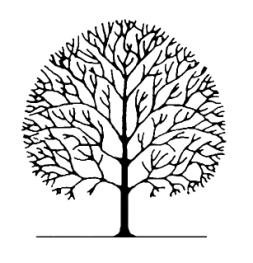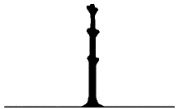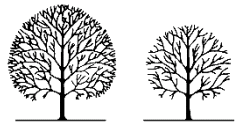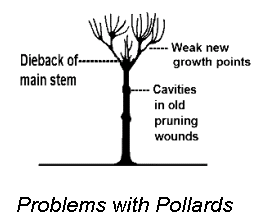Pruning deciduous broadleaf trees
In the wild, trees manage well enough, so why do we prune them? The first reason is simple: safety. Trees are big and when pieces fall off, they can do considerable damage.
Another reason, particularly for fruit trees, is to stimulate flowering and fruit production. Occasionally, pruning may be needed to remove disease or malformed branch work. Rarer still, pruning is sometimes needed for timber production, such as veneer wood. But, the most common reason of all is to control the growth and appearance of the tree for aesthetic reasons (particularly in cultivated varieties) or to control a perceived nuisance.
This page refers only to deciduous broadleaf trees in general, as evergreens and conifers often have different requirements. Also, it should be noted that even the trees dealt with here may have their own very specific requirements. The following is no more than a guide; if in doubt, seek expert advice.
Deciduous broadleaf trees are the most commonly found in England. They range from our native Oak to exotic species such as the Tulip Tree, from America. They all lose their leaves in winter.
A mature tree that has never been pruned will have a complicated arrangement of branches which may be seen best in winter.
The shape of the tree is dictated by the structural framework
of the main branches. If those are pruned, the shape of the tree will be changed.

A mature deciduous broadleaf tree without pruning

An extreme form of Lopping and Topping
In urban areas, trees used to be pruned by lopping and topping, a technique now generally frowned upon.
It leaves an unsightly pole of a tree. The regrowth often leaves weaknesses where branches could snap away and the risk of rot in the main stem is increased. Lime trees can tolerate this treatment better than most, but the result is often unattractive to look at. Other trees, such as Beech, can be killed by this treatment.
Crown reduction
Crown reduction gives a far more pleasing result where the overall size of a tree has to be reduced. Even trees that have been subjected to dramatic pruning in the past can sometimes be restored to a reasonable shape by this procedure. Crown reduction involves the overall reduction of just the crown of the tree, so there is little change in the overall height.
Such reductions are usually quoted as percentages, the usual maximum, being 30% (in the USA the limit is set at 25%). Greater reductions usually entail changes to the structural framework of the tree and can cause undue stress to the tree Only exceptionally will a larger reduction be justified. Most reductions will be in the 10% – 20% range, if the tree is amenable to such works in the first place.

Crown Reduction and Thinning
Where crown reduction would leave a dense mass of branches, thinning may also be carried out. Again, a guideline maximum is 30%.This procedure is best carried out in winter when it is easier to select the branches to be pruned. An exception to this is thinning selectively to decrease shade (see summer pruning).
Crown reduction in excess of 30% is often referred to now as pollarding, so-called after the old practice of pruning trees at 2-3 metres, still seen in riverside Willows. Nowadays, pollarding is often applied to any heavy reduction work that changes the structural framework of the tree.
Amenity Pollarding
Amenity Pollarding can be used to describe a modern alternative to the discredited lopping and topping. While not the procedure of choice, it is often the only option available for trees that have been badly managed in the past. Unless there are essential reasons, it should not be initiated on a tree, except as formative pruning when young.


If amenity pollarding is the only viable option, care must be taken to avoid creating a tree that is more eyesore than amenity. High pollarding is one such mistake. The resulting tree looks quite unnatural. However, it does have a place in a formal avenue, particularly of Planes, or Limes. This is more usually seen on the continent, as are other specialist pruning techniques, such as pleaching, annual pollarding, and umbrella pruning.
Crown lifting
As its name implies, this technique is used to increase the bare stem height below the crown.
Crown lifting may be done for a number of purposes. The most common is to obtain clearance above highways (up to 6 metres) and footpaths (up to 2.5 metres). It is also quite frequently employed in garden renovation, to free up ground below the tree, either for access, or to increase ambient light. None of these works should normally require removal of structural branches. More controversial reasons are when the tree is on a development site, or if the work is to increase vistas. Both these cases often require the removal of large low limbs of considerable age.
It is often hard to justify works to a mature tree just for a view, particularly when the pruning may require the loss of major branches. This can result in a poor looking tree and the wounding involved may unnecessarily shorten the life of the tree.

A Mature Tree Crown lifted for Highways, For light and access, Excessively
There are a number of cases where pruning requirements are for particular problems. A few examples are given below.
Clearance Pruning
Clearance pruning may be required when the canopy of a tree is very close to a building, especially to the north side. If the wind and sun cannot get to the building, the exterior becomes permanently damp and this encourages algae and moss to grow, which in turn increases the dampness. Clearance pruning should always be just of young growth.
Depending on the individual circumstances, 1 – 2 metres clearance between a building and the tree canopy should allow a reasonable airflow. This pruning may be required at regular intervals. There should not be an aesthetic problem here as the tree and building would be viewed in their totality, rather than as individual elements in the landscape.
Formative Pruning
Formative pruning is the procedure carried out on young specimen trees to remove foreseeable problems, such as tightly forked and rubbing stems; and to create the structural framework for the mature tree. In some ways it is akin to shrub pruning, but on a grander scale. There is no reason why such pruning should not be carried out from an early age until the desired final shape of the tree forms. Trees heal far better when young. This is when choosing a good specimen from a nursery pays dividends.
Bracing
Another past practice was bracing to prevent the forces of the wind taking their natural course. The problem is that once a tree is braced, by wire, chain or rod, it may be impossible to assess how safe it will remain. There is, however, a new flexible form of bracing that allows some natural movement in the tree, but reduces the worst effects of the wind. It also allows the controlled fall of a branch or stem if one does snap.
Fruit Pruning
Fruit pruning is highly specialised and is beyond the scope of this leaflet. Useful information should be found in the appropriate gardening books.
Note that non-commercial fruit trees are no longer exempt from the legislative controls for Conservation Areas. This may be related to the fact that people grub out old fruit trees on the basis that they are no longer productive, ignoring their amenity value.
When pruning out dead branches it is important to realise that the tree was aware of the dead branch long before it became visible to humans. The tree has probably already taken the necessary compensatory steps to protect further dieback. It follows that dead wood removal should be just that. Never cut beyond deadwood without taking expert advice, or you could undo all of the tree’s good works.
Wound Paint
The issue of wound paint is simple: trees have been around for millions of years losing branches and stems in storms and to the attentions of animals. Popular twenty years ago, it is now recognised that wound paint probably does nothing except promote disease by maintaining a humid atmosphere for fungi and bacteria to thrive in.
Summer Pruning
Summer pruning is recommended for some trees that weep copious amounts of sap. Species prone to this include Walnut, Hornbeam, Mulberry, Birch, Lime, Acers and some Poplars. It is also recommended for those trees that could otherwise suffer from infections prevalent in springtime, such as silver leaf of
Prunus. It can also be useful when thinning for ambient light.
It should, of course, be remembered that most trees can be pruned in the summer. The main obstacles to work being carried out at this time is the tree surgeons ability to see the structure of the tree, the fact that wood is difficult to cut when the sap is flowing and, last but by no means least – birds and bats may be using the tree for nesting or roosting! This is not something to take lightly as disturbing nesting birds or a bat roost is an offence. Trees and wildlife will be the subject of another note.
However, as far as the health of a tree is concerned, the only time pruning should never be done is during the spring growth period. Generally, this is March to June when the buds are swelling, bursting and then the new leaves are growing to their full size. The tree is investing stored energy at this time and can ill-afford to have it wasted.
Ivy Does not Strangle Trees
Ivy is very beneficial for wildlife. It is a natural component of the countryside providing food, roosts, nesting and hibernation sites for a wide variety of wildlife.
Ivy can cause damage, however, if it establishes in the crown or on limbs. The tree has developed in tune with its own weight. When Ivy gets high up into the tree, the extra loading it puts on branches can cause them to snap, particularly in high wind. More importantly, in the long term, Ivy can cover up problems in the stem of a tree. A good rule of thumb is that Ivy needs controlling once it appears as a mass in the crown.
The precise methods of pruning for homeowners are dealt in another leaflet, but if you are seeking information now, the keyword for searching in books, or on the internet is ‘target pruning’. This is a technique that complements the tree’s natural processes.
The local authority often gets asked to recommend tree surgeons. We do not do this as it interferes with free competition. However, it is strongly recommended that you always turn down the ‘today only’ offer from the uninvited caller, however much a bargain you may seem to be offered. More often than not the result is expensive butchery. Any tree surgeon worth his salt does not need to tout door-to-door for business.
If you need to trim trees near overhead cables, always employ a professional tree surgeon. Bringing down a telephone cable may be expensive, but shorting out electricity cables may be deadly.
We hope that you have found this information helpful. This is one of a series of leaflets on trees and wildlife. While we have tried to cover the broad outlines, there maybe something that we have missed.
Please note that this information is for guidance only. The terms and techniques used are to aid tree owners, no more.
Contact
Email: tree.enquiries@dover.gov.uk